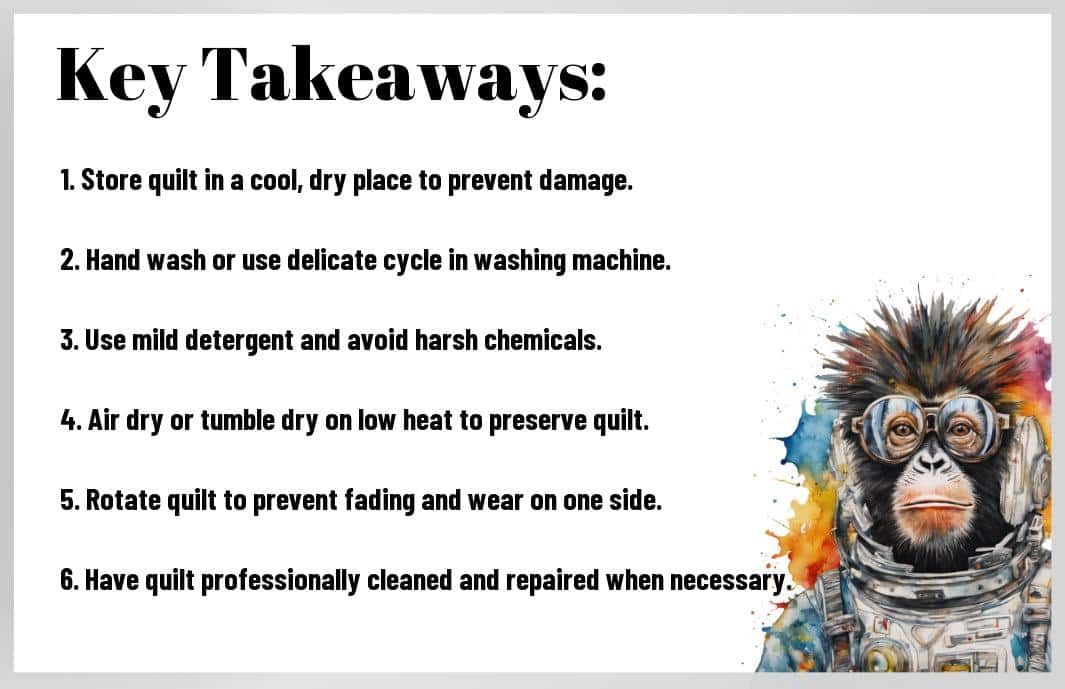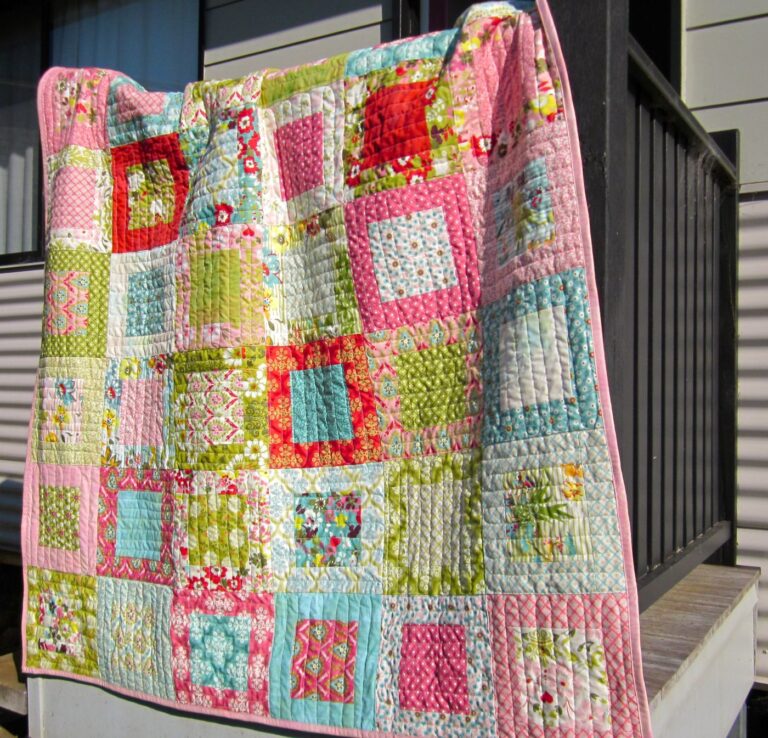How to Care for and Maintain Your Quilt
Congratulations on owning a beautiful quilt! Proper care and maintenance are essential to preserve its quality and longevity. Whether it’s an heirloom piece or a new addition to your home, taking the necessary steps to care for your quilt will ensure it remains in pristine condition for years to come.
In this informative blog post, we will provide you with valuable tips and techniques on how to properly clean, store, and repair your quilt so that you can enjoy its warmth and beauty for a lifetime. Understanding the dos and don’ts of quilt care is crucial in avoiding common mistakes that could potentially damage your beloved quilt. So, let’s dive deeper into the world of quilt care and maintenance together!
Table of Contents
Key Takeaways:
- Regular Cleaning: It is important to regularly clean your quilt to remove dust, dirt, and other debris that can degrade the fabric and cause damage over time. Frequent washing and airing out can keep your quilt looking fresh and feeling soft.
- Proper Storage: Storing your quilt properly can help prevent damage from pests, moisture, and sunlight. Use acid-free tissue paper and a breathable cotton storage bag to protect your quilt when not in use. Avoid plastic containers or bags, as they can trap moisture and lead to mildew and mold growth.
- Gentle Handling: When using and handling your quilt, be gentle to avoid tearing, fraying, or stretching the fabric. Avoid hanging your quilt on a clothesline, as this can cause stress to the seams and fabric. Instead, lay it flat to dry or use a quilt rack for support.

Daily and Seasonal Quilt Care
Assuming you use your quilt on a regular basis, it’s important to practice daily care to keep it in good condition. Additionally, seasonal care is essential to protect your quilt from environmental factors that can cause damage over time.

Proper Usage and Handling
When using your quilt on a daily basis, make sure to fold and smooth it out evenly to distribute any pressure or weight. Avoid stretching or pulling the fabric, as this can cause the stitching to weaken over time. When handling your quilt, be mindful of moisture and sharp objects that could potentially cause damage.
Protection from Environmental Factors
To protect your quilt from environmental factors such as sunlight, moisture, and dust, consider using a quilt storage bag when not in use. Additionally, rotate your quilt seasonally to prevent uneven exposure to light and potential fading. Recognizing the impact of these environmental factors is crucial for the longevity of your quilt.
- Sunlight: Direct sunlight can cause colors to fade over time. Avoid prolonged exposure to sunlight when displaying or storing your quilt.
- Moisture: Dampness can lead to mold and mildew, which can cause irreparable damage to your quilt. Store in a cool, dry place and consider using moisture-absorbing packs.
- Dust: Regularly shake out and air your quilt to prevent dust from settling and causing discoloration or deterioration.
Cleaning and Washing Your Quilt
After enjoying the warmth and comfort of your quilt, it’s important to know how to properly clean and maintain it. Regular cleaning and washing will help to preserve the fabric and ensure the longevity of your quilt. Here are some tips on how to clean and wash your quilt effectively.
Spot Cleaning Techniques
When it comes to dealing with small stains and spills on your quilt, spot cleaning is the best approach. You should act quickly to blot up any liquid with a clean, absorbent cloth or paper towel, taking care not to rub the stain, as this can cause it to spread. For dry stains, gently scrape off any residue using a plastic or wooden utensil. To treat the stain, mix a small amount of mild detergent with water and dab the affected area with the solution. Always test the cleaning solution on a small, inconspicuous area of the quilt first to ensure it does not cause any damage. Once the stain has been treated, blot the area with a clean, damp cloth to remove the detergent residue.
Washing and Drying Guidelines
When it comes time to give your quilt a thorough clean, it’s important to follow the manufacturer’s washing instructions. Some quilts may be machine washable, while others may require hand washing to avoid damage to the fabric and stitching.
Use a gentle, mild detergent and select a delicate or hand wash cycle with cold water to prevent shrinking or fading. Avoid using bleach or harsh chemicals, as these can weaken the fabric and cause it to deteriorate over time.
After washing, carefully air dry the quilt, laying it flat or hanging it on a line away from direct sunlight to prevent fading. Avoid using a dryer, as the heat and tumbling action can damage the delicate fabric and stitching of the quilt.
By following these washing and drying guidelines, you can ensure that your quilt remains clean and well-maintained for years to come.
Storage Solutions for Quilts
Keep your beloved quilts in top condition by storing them properly. Whether for short-term storage or long-term preservation, there are strategies you can employ to ensure that your quilts remain in pristine condition for years to come.
Short-Term Storage Strategies
When you need to store your quilts for a short period, such as when switching to a different quilt for the season, avoid folding your quilts for extended periods. Instead, consider hanging them on padded hangers in a closet to prevent creasing and distortion.
If hanging is not an option, you can roll your quilts around a tube and store them in a breathable cotton or muslin bag to protect them from dust and light exposure. It is crucial to choose a clean, dry, and well-ventilated storage area to prevent moisture and mildew from forming on your quilts.
Long-Term Preservation Methods
For long-term storage, such as preserving heirloom quilts or storing quilts during a move, it is essential to take additional precautions. First and foremost, avoid storing quilts in plastic containers or bags as they can trap moisture and lead to mildew and mold growth.
Instead, opt for acid-free storage boxes or containers and wrap your quilts in acid-free tissue paper to provide an extra layer of protection. Additionally, consider adding silica gel packets to absorb any excess moisture in the storage area.
Store your quilts in a cool, dark, and dry environment to prevent fading and degradation caused by light exposure and temperature fluctuations.
Repairing and Restoring Quilts
Not all quilts are lucky enough to stay in perfect condition forever. Over time, wear and tear can cause damage to your cherished quilt. However, with the right techniques and care, you can repair and restore your quilt to its former glory. Here’s how you can go about that:
Identifying Areas Needing Repair
When it comes to repairing and restoring your quilt, the first step is to identify the areas that need attention. Look for loose threads, fraying fabric, or areas where the stitching has come undone. Pay special attention to any areas that are in danger of becoming completely detached, as these can cause further damage if left unattended. Once you have identified the areas that need repair, you can move on to the next step of the process.
Techniques for Restoration and Preservation
When it comes to restoring and preserving your quilt, there are several techniques you can use to ensure that it remains in excellent condition. First and foremost, make sure to use high-quality, colorfast thread that matches the original stitching as closely as possible.
This will help to ensure that the repaired areas blend seamlessly with the rest of the quilt. Additionally, consider reinforcing weak areas with a lightweight, iron-on interfacing to provide extra stability and support. Finally, store your quilt in a clean, dry environment, away from direct sunlight and moisture, to prevent further damage.
By following these techniques, you can help to ensure that your quilt remains in beautiful condition for years to come.
Conclusion
So now you know the importance of caring for and maintaining your quilt. By following the simple steps we’ve outlined, you can ensure that your quilt remains in pristine condition for years to come.
Remember to regularly clean and store your quilt properly, and address any snags or tears promptly. With the right care, your quilt will continue to provide warmth and comfort for you and your loved ones. So take the time to care for your quilt, and it will reward you with a lifetime of cozy memories.
FAQ – How to Care for and Maintain Your Quilt
Q: How should I wash my quilt?
A: It is recommended to wash your quilt in a front-loading washing machine on a gentle cycle using mild detergent. Avoid washing it in a top-loading machine or hand washing, as these methods can cause damage to the quilt. Always wash in cold water to prevent colors from bleeding. It is important to air dry the quilt to avoid shrinkage and damage from the heat of the dryer.
Q: How do I store my quilt when not in use?
A: When storing your quilt, it is essential to keep it in a well-ventilated, cool, and dry space to prevent mold and mildew. Avoid storing it in plastic bags or containers, as these can trap moisture. It is recommended to fold the quilt carefully and wrap it in acid-free tissue paper to protect it from dust and light. Additionally, periodically refold the quilt to avoid permanent creases in the fabric.
Q: How can I protect my quilt from damage?
A: To protect your quilt from damage, it is important to use a quilt cover or duvet when using it on the bed to prevent excessive wear and tear. Additionally, avoid exposing the quilt to direct sunlight for prolonged periods, as this can cause fading and weakening of the fabric. Regularly rotate the quilt when using it to ensure even wear. Lastly, it is important to handle the quilt with clean hands to avoid transferring oils and dirt to the fabric.






